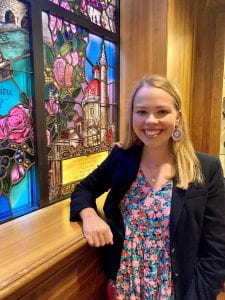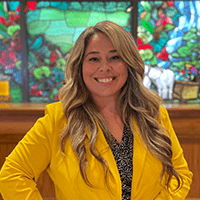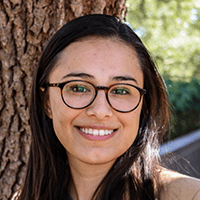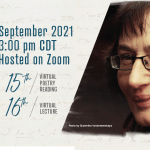by Anna Clark, Master’s Candidate in History and Armstrong Browning Library Graduate Assistant
On this year’s Browning Day, novelist Laura McNeal gave a lecture entitled, “How Much Bacon is in this Vegan Sandwich?: The Role of Invention in Historical Fiction,” describing her experience in writing The Swan’s Nest, a historical fiction novel detailing Robert Browning and Elizabeth Barrett’s courtship between 1844-1846. McNeal’s lecture was followed by a book-signing and reception downstairs in the Cox Reception Hall.
This year’s Browning Day celebration was held on Friday April 12th in the Hankamer Treasure Room and featured novelist Laura McNeal who gave a lecture on her most recent novel, The Swan’s Nest. In her opening remarks, Library Director Jennifer Borderud introduced the Armstrong Browning Library’s newest curator, Joanna Lamb, and welcomed the Baylor University Libraries Board of Advisors. Borderud acknowledged the culmination of an exciting week for the university and the city of Waco. Thousands of visitors flooded into Waco to observe the total solar eclipse on Monday April 8th, and the natural phenomenon did not disappoint despite cloudy skies prior to totality. Two of these visitors were Laura McNeal, this year’s featured Browning Day speaker, and her husband Tom McNeal.
Laura McNeal, 2024 Browning Day Lecturer
Laura McNeal is the author of Dark Water, which was a finalist for the National Book Award, and a two-time historical fiction novelist as well as the co-author of four other critically  acclaimed novels written with her husband Tom McNeal. She received her M.A. in fiction writing from Syracuse University and has been the recipient of two Armstrong Browning Library visiting research fellowships. These research visits to the ABL assisted McNeal in writing her latest novel, The Swan’s Nest, which explores the love story of two famous 19th-century poets, so near and dear to our library: Robert Browning and Elizabeth Barrett Browning. The Swan’s Nest, which was just released this March, covers the beginning of the Brownings’ courtship in 1844 leading up to their wedding in 1846 and their subsequent flight to Italy. In future works, McNeal intends to explore more of the Brownings’ 19th-century world as The Swan’s Nest is the first book in a planned trilogy.
acclaimed novels written with her husband Tom McNeal. She received her M.A. in fiction writing from Syracuse University and has been the recipient of two Armstrong Browning Library visiting research fellowships. These research visits to the ABL assisted McNeal in writing her latest novel, The Swan’s Nest, which explores the love story of two famous 19th-century poets, so near and dear to our library: Robert Browning and Elizabeth Barrett Browning. The Swan’s Nest, which was just released this March, covers the beginning of the Brownings’ courtship in 1844 leading up to their wedding in 1846 and their subsequent flight to Italy. In future works, McNeal intends to explore more of the Brownings’ 19th-century world as The Swan’s Nest is the first book in a planned trilogy.

How Much Bacon is in This Vegan Sandwich?
In her lecture “How Much Bacon is in this Vegan Sandwich?: The Role of Invention in Historical Fiction,” McNeal discussed the process of writing The Swan’s Nest and what she means when she says her novel is true to life. At first glance, McNeal observed, the descriptor “historical fiction” appears to be an oxymoron in the same way “bacon” and “vegan” are antithetical. How can a book be historical yet fictional? How can a vegan sandwich have bacon?
As McNeal explained in her lecture, the role of invention in historical fiction does not take away from the historical reality of what happened. Instead, historical fiction is a medium through which to welcome a new audience into the story of the past. Sometimes for the past to make sense or to understand how people in the past felt or perceived the events happening in their lives, a certain amount of artistic license is required. This is the role of invention in historical fiction: to interpret people or events in the past in order to fill gaps in their stories. In The Swan’s Nest, McNeal had to, metaphorically, put bacon in her vegan sandwich.
“That is the origin of my strange title. The book is historical but fiction. It’s non-fat, yet it has fat in it. It’s non-fictional fiction.”

A portrait of Sarianna Browning, the poet’s sister, hangs in the John Leddy-Jones Research Hall. McNeal lamented that this is one of the few depictions we have of Sarianna Browning. In her novel, McNeal brings Sarianna to life and gives her a voice and personality beyond this rather solemn face.
McNeal described the strange dichotomy of her craft in which she portrays many “fictional but historically possible” events and conversations between her characters. In The Swan’s Nest, she imagines not only Robert and Elizabeth’s courtship but also the reactions of their respective family members and friends to their relationship and eventual elopement. One of these characters was Robert’s younger sister Sarianna Browning; what we know of this intelligent and loyal woman is largely limited to her correspondence, notebooks, and sketches.
To bring Sarianna to life, McNeal had to create many of these “fictional but historically possible” scenarios. In the novel, she relies on a fictional yet historically possible conversation between Sarianna and Charles Dickens at a fictional but historically possible dinner party. In this dinner party scene, McNeal’s Sarianna frets about her outfit, comparing it to those of the other wealthier women in attendance, and displays nervousness in speaking to her literary idol, Dickens. To write these details about Sarianna’s character, McNeal used her own personal experiences. She saw something of herself in Sarianna and in the process, made Sarianna more relatable to modern audiences. Through McNeal’s storytelling, this often-forgotten sister of Robert Browning is able to step outside the poet’s shadow and tell her story–the story of a devoted sister who expressed understandable concerns about how her brother’s secret marriage to Elizabeth Barrett would impact his reputation and their family’s future financial security. Sarianna is not the only character that McNeal brings out of the wings into the limelight; Elizabeth’s sisters and brothers are also portrayed realistically and sympathetically in McNeal’s narrative. It is through many of these invented scenes and conversations in the novel that McNeal emphasizes the humanity of her characters.
The Historical Fiction Novel as a Séance
“A historical novelist is a medium,” McNeal told her audience. She described why chooses to explore the people past through historical fiction writing as it brings their voices to life in a way that biographies frequently fail to fully capture. Oftentimes as it is the case with historians and biographers of 19th-century figures, they are largely limited to what was written down and preserved in the archives. These records may not tell us everything we want to know about these people of the past. In her research for the novel, McNeal studied everything she could get her hands on, but she was not restricted by these historical sources. Instead, she used them to inform and expand upon the historical figures she chose to portray in her book. For example, McNeal used both Henrietta Barrett and Sarianna Browning’s sketchbooks to visualize her characters and their personalities. These sketchbooks, which are in the ABL’s possession, demonstrate these two women’s sense of humor and eye for beauty in the world around them.
“A medium claims to make you hear the voices of people you can’t see, to make things happen in your presence, and to connect you to the dead, to bring them back, and I think novels are the best séance there is.”
Like spiritual mediums who preside over séances, historical fiction authors encounter a lot of skepticism about the nature of their craft. The process of bringing the dead back to life is not easy; many will doubt and challenge whether novelists truly heard the voices of the past and interpreted them correctly–in other words, whether their stories are true to life.
McNeal is not alone in juggling this precarious balance between invention and truth in her writing. One of McNeal’s characters, Elizabeth Barrett herself, too employed invention when she wrote about Adam and Eve’s banishment from the Garden of Eden in “A Drama of Exile.” McNeal described how Elizabeth wrote a defense of her depiction of twilight in Eden since she was worried that literary critics and religious leaders would condemn her for making twilight “too long” in the Biblical story and therefore, historically inaccurate.

Dr. A.J. Armstrong commissioned these stained-glass windows in the Foyer of Meditation to look like dawn or dusk, the hours of the day that he believed the most artistic inspiration occurred. These purple-gold windows also evoke Elizabeth’s long purple twilight in “A Drama of Exile.”
As McNeal argued throughout her lecture, complete historical accuracy is not a standard we should hold historical fiction to; that kind of literary analysis should be reserved for biographies and history books. What she and other historical fiction writers do is take the past and make it into a cohesive narrative by imagining what it would have been like for that person to live in that time or place, using the historical record to guide their literary portrayal. McNeal explained further that all of us interpret and formulate images in our minds about the past in unique ways, and these ideas may not correlate with how others have imagined past people or events. That is perfectly okay because creativity and personal interpretation are part of the genre.
The ABL as a Place Where “the Past Doesn’t Die”
McNeal compared the way historical fiction novelists connect us to the dead to the way museums and libraries do. In her presentation, she stressed the importance of stories behind the objects we have on display, whether they are in a public museum exhibit and or on the shelf in our homes. By holding on to these relics of the past and passing the stories associated with them to the next generation, we are keeping the tenuous link to the dead alive. McNeal described the ABL as a place where “the past doesn’t die,” thanks to the Library’s continued effort to preserve and expand our collections.
In particular, McNeal referenced a letter by J.A.L. Sterling, which is part of a recent collection donated to the ABL by the family of Elaine Baly (Vivienne Browning), a descendant of Robert Browning’s uncle Reuben Browning. In this letter, Sterling lamented the demolition of Robert Browning’s home at 19 Warwick Crescent, located in the Paddington neighborhood of London. Before the home was torn down, Sterling snuck in and took photographs, which he enclosed in the letter to Elaine Baly. He also salvaged the door to Robert Browning’s study. Sterling made this door into a desk upon which he wrote his book manuscript on world copyright law, hoping that some of Browning’s genius would seep from the door into his pen.

For her lecture, McNeal examined J.A.L. Sterling’s letter to Elaine Baly (Vivienne Browning) describing his efforts to save 19 Warwick Crescent from demolition in the 1950s along with his pictures of the house before it was destroyed. The photographs and letter are now part of the Elaine Baly (Vivienne Browning) Collection gifted to the ABL by her son John Baly in November 2023.
We know what the interior of Robert Browning’s home at 19 Warwick Crescent looked like thanks to Sterling’s photographs and descriptions. We have these photographs because Elaine Baly kept the letter, and her son John chose to donate her Browning paraphernalia to the ABL instead of discarding the items. This fragile link to the past has been preserved thanks to the individual actions of many different players who saw the value in remembering Robert Browning’s life at Warwick Crescent.
Continuing this theme of doors associated with the Brownings, McNeal also discussed a visit to Wellesley College in which she touched the door that once stood guard at the Barrett residence on Wimpole Street–the very same door whose slot Robert’s letters to Elizabeth would have been slipped through and the very same door that Robert himself would have knocked in order to gain entry into the Barrett home on May 16, 1844, to meet his future wife for the first time.
McNeal acknowledged the tangible history that the Wimpole Street door represented along with the lovely letters and poems that both Elizabeth Barrett and Robert Browning wrote to one another. However, as much as McNeal appreciates the preservation of these historical objects associated with the Brownings, she explained that she is much more interested in the lives of these poets, in which the door served as a symbol, the opening of a legendary love story.
“It is the life that followed the letters…it’s the story, knowing the story, telling the story, and most of all, believing the story that gives the object value.”

A diorama on display in the Elizabeth Barrett Browning Salon depicting the first meeting between Robert Browning and Elizabeth Barrett in her bedroom at No. 50 Wimpole Street. This diorama, McNeal stated in her lecture, is one of her favorite items on display in the ABL.
As in the cases of J.A.L. Sterling’s door-turned-desk and the Wimpole Street door at Wellesley, the stories behind non-fictional objects make them valuable. McNeal observed that the ABL’s Hankamer Treasure Room would not be a treasure room unless there were treasures contained within–for what is a museum without treasures? But what makes these items treasures? A lock of hair belonging to Robert Browning has value because we know who Robert Browning was; we know the story of his extraordinary life, and we continue to tell the story of his life. What particularly stands out for McNeal in the story of Robert Browning’s life is his steadfast love for Elizabeth Barrett and hers for him.
“At the core of the Robert Browning and Elizabeth Barrett’s myth is the Greek myth about Cupid and Psyche. Love makes the soul immortal.”
The love shared between our two eponymous poets is what draws thousands of visitors to our Library every year. The Brownings’ love for one another is what gives greater beauty and depth to their poetry, and this enduring love story is reflected throughout the ABL. One only has to read Elizabeth’s famous Sonnet 43 inscribed on the wall in the Cloister of the Clasped Hands and admire the stained-glass windows in the Elizabeth Barrett Browning Salon to see the continuing appeal of the Brownings’ love story. We all dream of a love like theirs, which almost seems mythical–too good to be true.
The Enduring Myth of the Brownings’ Love

One of the stained-glass windows in the Elizabeth Barrett Browning Salon represents the lines of the first sonnet from the “Sonnets from the Portuguese”: “The silver answer rang…Not Death but Love.” The sonnets, although published later, were written by Elizabeth during the Brownings’ courtship, and this first sonnet foreshadows that the coming change in her life is to be Robert’s love, not death as she originally feared.
An audience member asked McNeal how the Brownings’ idea of love shaped her idea of love. Throughout her lecture, McNeal expressed her hope that her novel will leave readers wanting to learn more about the Brownings, to seek out their history, and to visit the libraries and museums which house the treasures of their lives. As for her characters’ influence on her, McNeal shared that her own dive into Brownings’ love story made her want to be a better person, and their faithfulness to one another through life’s trials was inspirational.
Robert and Elizabeth’s love story is one that endures, largely in part due to their prolific poetry and letters, but also because of people like McNeal who take up their pen and tell the Brownings’ story again.
“The whole point of a myth is to see ourselves in it and be able to interpret our experiences through it and tell it again…”
McNeal closed her lecture with a reading from her novel, The Swan’s Nest, and afterwards, answered other audience questions and signed books in the Cox Reception Hall. We encourage you to check out McNeal’s retelling of the famous love story of the Brownings in her book, The Swan’s Nest, and to keep an eye out for the next installations in the trilogy.
If you are interested in watching a video recording of McNeal’s lecture, the following link is provided: 2024 Armstrong Browning Library & Museum Browning Day featuring novelist Laura McNeal (youtube.com)











 On November 17th, The Armstrong Browning Library had the distinct privilege to learn about a fascinating historical figure in the lecture “Harriet Martineau, Spirit of the Victorian Age” from the distinguished Dr. Deborah A. Logan, this year’s speaker for Benefactors Day. Benefactors Day is a yearly celebration of our wonderful community of supporters that ensures the future of the Armstrong Browning Library’s scholarship and programming work. A professor emerita of Victorian Literature at Western Kentucky University, Dr. Logan captured this year’s audience by shedding light on the life and works of the Victorian author, economist, journalist, sociologist, and Browning correspondent, Harriet Martineau.
On November 17th, The Armstrong Browning Library had the distinct privilege to learn about a fascinating historical figure in the lecture “Harriet Martineau, Spirit of the Victorian Age” from the distinguished Dr. Deborah A. Logan, this year’s speaker for Benefactors Day. Benefactors Day is a yearly celebration of our wonderful community of supporters that ensures the future of the Armstrong Browning Library’s scholarship and programming work. A professor emerita of Victorian Literature at Western Kentucky University, Dr. Logan captured this year’s audience by shedding light on the life and works of the Victorian author, economist, journalist, sociologist, and Browning correspondent, Harriet Martineau.


 Anna Clark
Anna Clark school from there, then made my way to the Texas Hill Country where I went to school at Texas State in San Marcos and received my Bachelor of Science in Family and Consumer Science, and a Minor in Mass Communications. After college, I entered the events/wedding industry where I worked for over a decade coordinating events and weddings. I also managed a floral company for weddings and specialty events.
school from there, then made my way to the Texas Hill Country where I went to school at Texas State in San Marcos and received my Bachelor of Science in Family and Consumer Science, and a Minor in Mass Communications. After college, I entered the events/wedding industry where I worked for over a decade coordinating events and weddings. I also managed a floral company for weddings and specialty events. Katherine, who is a current Baylor PhD student (in history). Previously, I worked as the theology editor for Christianity Today magazine until 2020, when I left full-time work there to pursue my own PhD in theology (at Trinity Evangelical Divinity School in Illinois).
Katherine, who is a current Baylor PhD student (in history). Previously, I worked as the theology editor for Christianity Today magazine until 2020, when I left full-time work there to pursue my own PhD in theology (at Trinity Evangelical Divinity School in Illinois). Spanish at Wheaton College, and then moved to Boston to attend Simmons University for my M.L.I.S. degree. I concentrated in cultural heritage studies and explored the many different historic landmarks, museums, and libraries of New England as a student. After my wedding last summer in Maine, I moved to Texas to join my husband, David Criscione, as he completes his PhD program here at Baylor.
Spanish at Wheaton College, and then moved to Boston to attend Simmons University for my M.L.I.S. degree. I concentrated in cultural heritage studies and explored the many different historic landmarks, museums, and libraries of New England as a student. After my wedding last summer in Maine, I moved to Texas to join my husband, David Criscione, as he completes his PhD program here at Baylor.





